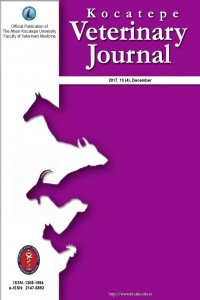Formalin ile Tespit Edilmiş Çizgili Kas Dokuları Üzerine Borik AsitinMuhtemel Koruyucu Etkisinin Araştırılması
Öz
Anahtar Kelimeler
Borik asit Tespit solüsyonu Formalin Çizgili kas dokusu Histopatoloj.
Kaynakça
- Benkhadra M, Bouchot A, Gérard J, Genelot D, Trouilloud P, Martin L, Girard C, Danino A, Anderhuber F, Feigl G. Flexibility of Thiel’s embalmed cadavers: the explanation is probably in the muscles. Surg Radiol Anat. 2011; 33:365-368.
- Brenner E. Human body preservation – old and new techniques. J Anat. 2014; 224:316- 344
- Davidson SS, Benjamin WH Jr. Risk of infection and tracking of work-related infectious diseases in the funeral industry. Am J Infect. Control. 2006; 34:655–660.
- Dokuzlu C. Gıda Analizleri. Marmara Kitapevi Yayınları, Bursa. 2004.
- Duong A Steinmausa C, McHalea CM, Vaughan CP, Zhang L. Reproductive and developmental toxicity of formaldehyde: A systematic review. Mutat Res. 2011; 728:118–138.
- Halkman K. Gıda Mikrobiyolojisi Uygulamaları. Başak Matbaacılık ve Tanıtım Hizmetleri Ltd.Şti., Ankara. 2005.
- ISO (INTERNATIONAL STANDARD ORGANISATION) 4833. Horizontal method for the enumeration of microorganism. Colony count technique at 30oC. 2003.
- Janczyk P, Weigner J, Luebke-Becker A, Kaessmeyer S, Plendl J. Nitrite pickling salt as an alternative to formaldehyde for embalming in veterinary anatomy--A study based on histo- and microbiological analyses. Ann Anat. 2011; 193(1):71-5.
- Koburger JA, Marth EH. Yeast and Moulds. In: Speck, M.L., Compendium of Methods For the Microbiological Examination of Foods (APHA). Washington. USA. 197 – 201. 1984 Kabu M, Akosman MS. Biological effects of boron. Rev Environ Contam Toxicol. 2013; 225:57-75.
- Nielsen GD, Larsen ST, Wolkoff P. Recent trend in risk assessment of formaldehyde exposures from indoor air. Arch Toxicol. 2013; 87:73–98.
- Onyije FM, Avwioro OG. Excruciating effects of formaldehyde exposure to students in gross anatomy dissection laboratory. Int J Occup Environ Med. 2012; 3:92-95.
- Penland JG. .Dietary Boron, Brain Function, and Cognitive Performance. Environ Health Perspect. 1994; 102:65-72.
- Shoja MM, Benninger B, Agutter P, Loukas M, Tubbs RS. A historical perspective: infection from cadaveric dissection from the 18th to 20th centuries. Clin Anat. 2013; 26:154–160.
- Thavarajah R, Mudimbaimannar VK, Elizabeth J, Rao UK, Ranganathan K. Chemical and physical basics of routine formaldehyde fixation. J Oral Maxillofac Pathol. 2012; 16:400-5. Thiel W. The preservation of the whole corpse with natural color. Ann Anat. 1992; 174:185-195.
- Trompette P, Lemonnier M. Funeral embalming: the transformation of amedical innovation. Sci. Stud. 2009; 22:9–30.
- Turan E, Gules O, Kilimci FS, Kara ME, Dilek OG, Sabanci SS, Tatar M. The mixture of liquid foam soap, ethanol and citric acid as a new fixative– preservative solution in veterinary anatomy. Ann Anat. 2017; 209:11-17.
- Turkez H, Geyiklioglu F. Boric acid: a potential chemoprotective agent against aflatoxin b1 toxicity in human blood. Cytotechnology. 2010; 62:157-165.
- Yilmaz MT. Minimum inhibitory and minimum bactericidal concentrations of boron compounds against several bacterial strains. Turk J Med Sci. 2012; 42:1423- 1429.
The Investigation of Potential Preservative Effect of Boric Acid on Formalin Fixed Striated Muscle Tissues
Öz
Anahtar Kelimeler
Boric acid Fixation solution Formalin Striated muscle tissue Histopathology
Kaynakça
- Benkhadra M, Bouchot A, Gérard J, Genelot D, Trouilloud P, Martin L, Girard C, Danino A, Anderhuber F, Feigl G. Flexibility of Thiel’s embalmed cadavers: the explanation is probably in the muscles. Surg Radiol Anat. 2011; 33:365-368.
- Brenner E. Human body preservation – old and new techniques. J Anat. 2014; 224:316- 344
- Davidson SS, Benjamin WH Jr. Risk of infection and tracking of work-related infectious diseases in the funeral industry. Am J Infect. Control. 2006; 34:655–660.
- Dokuzlu C. Gıda Analizleri. Marmara Kitapevi Yayınları, Bursa. 2004.
- Duong A Steinmausa C, McHalea CM, Vaughan CP, Zhang L. Reproductive and developmental toxicity of formaldehyde: A systematic review. Mutat Res. 2011; 728:118–138.
- Halkman K. Gıda Mikrobiyolojisi Uygulamaları. Başak Matbaacılık ve Tanıtım Hizmetleri Ltd.Şti., Ankara. 2005.
- ISO (INTERNATIONAL STANDARD ORGANISATION) 4833. Horizontal method for the enumeration of microorganism. Colony count technique at 30oC. 2003.
- Janczyk P, Weigner J, Luebke-Becker A, Kaessmeyer S, Plendl J. Nitrite pickling salt as an alternative to formaldehyde for embalming in veterinary anatomy--A study based on histo- and microbiological analyses. Ann Anat. 2011; 193(1):71-5.
- Koburger JA, Marth EH. Yeast and Moulds. In: Speck, M.L., Compendium of Methods For the Microbiological Examination of Foods (APHA). Washington. USA. 197 – 201. 1984 Kabu M, Akosman MS. Biological effects of boron. Rev Environ Contam Toxicol. 2013; 225:57-75.
- Nielsen GD, Larsen ST, Wolkoff P. Recent trend in risk assessment of formaldehyde exposures from indoor air. Arch Toxicol. 2013; 87:73–98.
- Onyije FM, Avwioro OG. Excruciating effects of formaldehyde exposure to students in gross anatomy dissection laboratory. Int J Occup Environ Med. 2012; 3:92-95.
- Penland JG. .Dietary Boron, Brain Function, and Cognitive Performance. Environ Health Perspect. 1994; 102:65-72.
- Shoja MM, Benninger B, Agutter P, Loukas M, Tubbs RS. A historical perspective: infection from cadaveric dissection from the 18th to 20th centuries. Clin Anat. 2013; 26:154–160.
- Thavarajah R, Mudimbaimannar VK, Elizabeth J, Rao UK, Ranganathan K. Chemical and physical basics of routine formaldehyde fixation. J Oral Maxillofac Pathol. 2012; 16:400-5. Thiel W. The preservation of the whole corpse with natural color. Ann Anat. 1992; 174:185-195.
- Trompette P, Lemonnier M. Funeral embalming: the transformation of amedical innovation. Sci. Stud. 2009; 22:9–30.
- Turan E, Gules O, Kilimci FS, Kara ME, Dilek OG, Sabanci SS, Tatar M. The mixture of liquid foam soap, ethanol and citric acid as a new fixative– preservative solution in veterinary anatomy. Ann Anat. 2017; 209:11-17.
- Turkez H, Geyiklioglu F. Boric acid: a potential chemoprotective agent against aflatoxin b1 toxicity in human blood. Cytotechnology. 2010; 62:157-165.
- Yilmaz MT. Minimum inhibitory and minimum bactericidal concentrations of boron compounds against several bacterial strains. Turk J Med Sci. 2012; 42:1423- 1429.
Ayrıntılar
| Bölüm | ARAŞTIRMA MAKALESİ |
|---|---|
| Yazarlar | |
| Yayımlanma Tarihi | 1 Aralık 2017 |
| Kabul Tarihi | 13 Kasım 2017 |
| Yayımlandığı Sayı | Yıl 2017 Cilt: 10 Sayı: 4 |
Kaynak Göster


